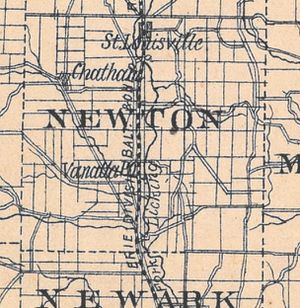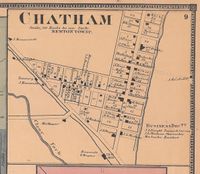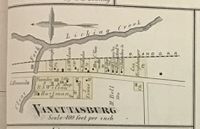Difference between revisions of "Newton Township"
| Line 20: | Line 20: | ||
[[File:Chatham 1866 atlas.jpg|200px|thumb|left|Inset map of village of Chatham from 1866 Atlas of Licking County.]][[Chatham]], originally called Harrisburg, was founded by John Waggoner in 1829. The population rose to more than two-hundred inhabitants by 1860, but declined later in the nineteenth century. <ref> ''Combination Atlas Map of Licking County, Ohio'', ed. L.H. Everts,(1875), 120 </ref> Situated on the north bank of the Clear Fork, a post office first opened in the village in 1836, but closed within the year. It reopened in 1837, and closed again on December 5, 1894. It reopened the following day under the name of Norman Post Office to finally close in August 1902. At its height in the mid-nineteenth century, the community boasted a barber, four blacksmiths, a mill, tannery, and tavern <ref> ''Ohio Ghost Towns: No 44 Licking County'', ed. Helwig and Helwig, (1998), 48 </ref> | [[File:Chatham 1866 atlas.jpg|200px|thumb|left|Inset map of village of Chatham from 1866 Atlas of Licking County.]][[Chatham]], originally called Harrisburg, was founded by John Waggoner in 1829. The population rose to more than two-hundred inhabitants by 1860, but declined later in the nineteenth century. <ref> ''Combination Atlas Map of Licking County, Ohio'', ed. L.H. Everts,(1875), 120 </ref> Situated on the north bank of the Clear Fork, a post office first opened in the village in 1836, but closed within the year. It reopened in 1837, and closed again on December 5, 1894. It reopened the following day under the name of Norman Post Office to finally close in August 1902. At its height in the mid-nineteenth century, the community boasted a barber, four blacksmiths, a mill, tannery, and tavern <ref> ''Ohio Ghost Towns: No 44 Licking County'', ed. Helwig and Helwig, (1998), 48 </ref> | ||
| − | [[File:1875 atlas vanatta.jpeg|200px|thumb|left|Detailed map of village of Vanatta from 1875 Atlas of Licking County.]]Established in 1857, [[Vanatta]], or Vanattasburgh as it was originally called, was a small manufacturing center north of Newark at the junction of the Clear and North Forks of the Licking. The impetus for the establishment of the village was the arrival of the railroad in the 1850s, which led to a rail depot and corresponding cluster of homes and businesses. Though there are many people who bear the surname "Vanatta" in Licking County, which one gave their name to the village remains a bit of a mystery. The nineteenth-century chroniclers of local history were surprisingly silent on that Vanatta's first name. The most likely prospect was Jesse Vanatta, who purchased a large plot of land in the area in the 1830s. He granted the railroad right-of-way through his property for the rail line, but he died in 1852 before the railroad was finished and the village was founded. It is possible that the village was named after Jesse after his death or in honor of his children who inherited many lots. Vannatta may have existed as a settlement decades before it was officially recognized; the obituary of a daughter of Jesse Vanatta recorded that her father ran a blacksmith shop and a tavern on what was a stage coach route years before the railroad arrived. The village had about 18 residences, a few businesses, and a school. <ref> Massa, P., "Advocate Salutes Vanatta," ''Newark Advocate'', Jun. 9, 1965, 1; "Obituary: Amanda Vanatta Stewart," ''Newark Advocate'', Dec. 31, 1915, 6. "Obituary: Ellen VanAtta," ''Newark Daily Advocate'', Jun. 5, 1893, 8. The first article credits the family arriving in 1839, the second provided 1831 for the arrival of the family of Jesse Vanatta to Licking County, and the third, and most likely, declared their arrival date 1837. </ref> | + | [[File:1875 atlas vanatta.jpeg|200px|thumb|left|Detailed map of village of Vanatta from 1875 Atlas of Licking County.]]Established in 1857, [[Vanatta]], or Vanattasburgh as it was originally called, was a small manufacturing center north of Newark at the junction of the Clear and North Forks of the Licking. The impetus for the establishment of the village was the arrival of the railroad in the 1850s, which led to a rail depot and corresponding cluster of homes and businesses. <ref> Massa, P., "Advocate Salutes Vanatta," ''Newark Advocate'', Jun. 9, 1965, 1; Brister, E., ''Centennial History of Newark'', (1909), 329 </ref> The village was always a small one; in 1880, Vanatta had a total population of 81 inhabitants. <ref> Hill, N., ''History of Licking County'', (1881), 81 </ref> Though there are many people who bear the surname "Vanatta" in Licking County, which one gave their name to the village remains a bit of a mystery. The nineteenth-century chroniclers of local history were surprisingly silent on that Vanatta's first name. The most likely prospect was Jesse Vanatta, who purchased a large plot of land in the area in the 1830s. He granted the railroad right-of-way through his property for the rail line, but he died in 1852 before the railroad was finished and the village was founded. It is possible that the village was named after Jesse after his death or in honor of his children who inherited many lots. Vannatta may have existed as a settlement decades before it was officially recognized; the obituary of a daughter of Jesse Vanatta recorded that her father ran a blacksmith shop and a tavern on what was a stage coach route years before the railroad arrived. The village had about 18 residences, a few businesses, and a school. <ref> Massa, P., "Advocate Salutes Vanatta," ''Newark Advocate'', Jun. 9, 1965, 1; "Obituary: Amanda Vanatta Stewart," ''Newark Advocate'', Dec. 31, 1915, 6. "Obituary: Ellen VanAtta," ''Newark Daily Advocate'', Jun. 5, 1893, 8. The first article credits the family arriving in 1839, the second provided 1831 for the arrival of the family of Jesse Vanatta to Licking County, and the third, and most likely, declared their arrival date 1837. </ref> |
[[Cannonsburg]], or Fairfield, was a settlement planned on Dry Creek in Newton Township in 1805 by a man named Elliott in 1805. This made it the second planned community in the region, even before Licking County was partitioned from Fairfield, hence the initial name for the village. Fairfield became known as Cannonsburg from Thomas Cannon who kept a tavern at the location. The community never became more than an aspiration, however, lacking even a post office. Cannonsburg would eventually dissolve in the nineteenth century as the few small houses at the site were abandoned. <ref> Brister, E., ''Centennial History of the City of Newark'', (1909), 145; ''Ohio Ghost Towns: No 44 Licking County'', ed. Helwig and Helwig, (1998), 46 </ref> | [[Cannonsburg]], or Fairfield, was a settlement planned on Dry Creek in Newton Township in 1805 by a man named Elliott in 1805. This made it the second planned community in the region, even before Licking County was partitioned from Fairfield, hence the initial name for the village. Fairfield became known as Cannonsburg from Thomas Cannon who kept a tavern at the location. The community never became more than an aspiration, however, lacking even a post office. Cannonsburg would eventually dissolve in the nineteenth century as the few small houses at the site were abandoned. <ref> Brister, E., ''Centennial History of the City of Newark'', (1909), 145; ''Ohio Ghost Towns: No 44 Licking County'', ed. Helwig and Helwig, (1998), 46 </ref> | ||
Revision as of 08:39, 19 July 2022
The North Fork of the Licking River flows from North to South, bisecting the township. A number of smaller streams, including Dry Creek and the Clear Fork drain from both east and west into the North Fork. A central flat region bounds each bank of the North Fork in an otherwise rugged hill region. A similar series of bottomlands surround the Clear Fork amidst similar rugged terrain. [1]
Contents
Moundbuilders and Native American settlement
A number of mounds were once located in Newton Township; there were nine mounds and one enclosure recorded in the 1914 Archaeological Atlas of Ohio. [2] The two most notable mounds were located near the junctures of Dry Creek and the North Fork, and the North Fork and Clear Fork respectively. [3]
Early European Settlement
The Evans family – John and George Washington – were the first European settlers in the Township in 1803. New residents trickled in over the next few years with a larger influx from 1808 leading to the establishment of the township in 1809. John Henthorn built the township's first grist-mill in 1806 and several mills followed on the district's numerous rivers and runs. [4] The township's most renowned early settler was General John Spencer. Spencer arrived and settled along the North Fork in 1805. A creek near the site of his homestead became known as "Spencer's Run." John Spencer fought in the War of 1812 as a captain in charge of a locally raised soldiers. He would later serve in the Ohio state legislature (1814-1817 Representative, 1818-1822 Senator). 583. Spencer was one of the American soldiers paroled after the Battle of Detroit in 1812. Despite his parolee status, Spencer returned to command his company on the front lines of combat and served under General William Henry Harrison. The company of local militia that served under Spencer and continued as a reserve force became known as the "Newton Blues." [5]
Communities
Newton Township had a spurt of growth in the 1850s with the arrival of the railroad line that runs along the North Fork of the Licking. A few small communities predate the arrival of rail, but most became centered along the railroad that paralleled the North Fork.The township's largest village is St. Louisville. E.M.P. Brister, in his Centennial History of Newark and Licking County, gave two close dates and two sets of founders: John Bell and Stephen Ritter (1839), and separately, John Evans (1840). The confusion may lie in the initial plans laid out by the former pair and then an expansion of village lots by Evans and a Wesley Coffman. [6] With the assistance of the railroad, the village grew and numbered 282 inhabitants in 1900. [7] The Coffman Mill, which required a long mill race between the village and the North Fork, was a prominent early business. In 1883, the village had several grocers, a blacksmith, a physician, and possibly even a hotel run by a John Turbott. [8] Today the village has a grocery, several restaurants, and other businesses as well as its own police department. Less than a mile south of St. Louisville, there was once a small community called Houston Mills, or Newton Mills, which acquired the first post office in the township in 1826. The post office and community were superseded by the growth of St. Louisville. [9]
Cannonsburg, or Fairfield, was a settlement planned on Dry Creek in Newton Township in 1805 by a man named Elliott in 1805. This made it the second planned community in the region, even before Licking County was partitioned from Fairfield, hence the initial name for the village. Fairfield became known as Cannonsburg from Thomas Cannon who kept a tavern at the location. The community never became more than an aspiration, however, lacking even a post office. Cannonsburg would eventually dissolve in the nineteenth century as the few small houses at the site were abandoned. [15]
The growth of Newark led that city to expand northward and annex the southern portions of Newton Township.
Newton Township remains rural today with its small communities and a population just over 3,000. [16]
For more information see also:
J.G.
Return to Townships and Communities main page.
References
- ↑ Hill, N., History of Licking County, (1881), 577
- ↑ Mill, W., Archaeological Atlas of Ohio, (1914), 45
- ↑ Hill, N., History of Licking County, (1881), 577. Dry Creek was called the "Brushy Fork" in the nineteenth century, but this created confusion with the other stream currently named the Brushy Fork of the Licking that flows through Hanover Township
- ↑ Hill, N., History of Licking County, (1881), 577, 581
- ↑ Hill, N., History of Licking County, (1881), 583-584
- ↑ Brister, E., Centennial History of Newark, (1909), 249, 329
- ↑ Brister, E., Centennial History of Newark, (1909), 248
- ↑ Directory of Newark 1883-1884, (1883), 174
- ↑ Ohio Ghost Towns: No 44 Licking County, ed. Helwig and Helwig, (1998), 102
- ↑ Combination Atlas Map of Licking County, Ohio, ed. L.H. Everts,(1875), 120
- ↑ Ohio Ghost Towns: No 44 Licking County, ed. Helwig and Helwig, (1998), 48
- ↑ Massa, P., "Advocate Salutes Vanatta," Newark Advocate, Jun. 9, 1965, 1; Brister, E., Centennial History of Newark, (1909), 329
- ↑ Hill, N., History of Licking County, (1881), 81
- ↑ Massa, P., "Advocate Salutes Vanatta," Newark Advocate, Jun. 9, 1965, 1; "Obituary: Amanda Vanatta Stewart," Newark Advocate, Dec. 31, 1915, 6. "Obituary: Ellen VanAtta," Newark Daily Advocate, Jun. 5, 1893, 8. The first article credits the family arriving in 1839, the second provided 1831 for the arrival of the family of Jesse Vanatta to Licking County, and the third, and most likely, declared their arrival date 1837.
- ↑ Brister, E., Centennial History of the City of Newark, (1909), 145; Ohio Ghost Towns: No 44 Licking County, ed. Helwig and Helwig, (1998), 46
- ↑ https://lickingcounty.gov/civicax/filebank/blobdload.aspx?BlobID=49115



